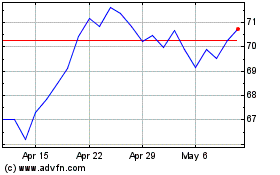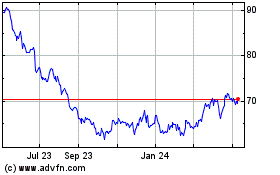(Editor's Note: This item originally appeared earlier today. It
is being sent to run on additional wires.)
By Annie Gasparro
Food makers are racing to find acceptable alternatives to sugar.
But it's hard to replace a taste that so many Americans have grown
to love.
Traditional sweeteners -- from sucrose, or table sugar, to
high-fructose corn syrup -- are an increasing concern to consumers
and lawmakers, who see them as a key culprit in America's obesity
and diabetes epidemic.
Now researchers at food giants, startups and universities are
looking for new ways to make foods sweet without putting people's
health at risk. Some are testing out natural zero-calorie
ingredients like monkfruit and South American root extracts that
are so intensely sweet that they can add flavor without calories.
Others are manipulating granules of sugar to make them taste
sweeter. They're also developing new ingredients that will block
bitter taste receptors and make food seem like it has more sugar
than it does.
Nestlé SA scientist Olivier Roger, who's leading the food
titan's sugar-reduction effort globally, says many companies are
working on finding answers. Adding to the urgency: Some companies,
like Nestlé, have self-imposed deadlines for lowering sugar content
in food.
But there are big challenges to removing what has been a key
ingredient in processed food for over a century.
For one thing, there are side effects to removing sugar: It not
only adds sweetness but also functions as a preservative and adds
texture, as well as contributing to the overall volume of food.
Whole recipes have to be rethought when it is removed. And after
finding an alternative, companies may face higher costs, supply
constraints or regulatory hurdles related to the substitute
ingredients.
"It's very difficult, very complex. We still don't have the
magic solution that would replace sugar," Mr. Roger says.
The push comes amid a widespread effort to put the brakes on
sugar consumption. In a survey released by market-research firm
Nielsen earlier this year, 22% of respondents said they already
restrict their sugar intake. Most major food makers, including Mars
Inc., General Mills Inc. and Kellogg Co., have pledged to reduce
sugar in candy, children's cereals and other products.
Last year, the federal government called out sugar consumption
as a problem in the U.S. Dietary Guidelines, recommending for the
first time that people consume no more than 10% of their daily
calories from added, or refined, sugars. Americans currently
average 13% of their calories from added sugar, the report
says.
Regulators also said last year that food and beverage makers
will be required to disclose on nutrition labels how much sugar has
been added to products, as a distinct item within the total sugar
content. The FDA recently extended the deadline for the new labels
to Jan. 1, 2020 from July 2018.
Cutting the amount of sugar will be a steep task. More than
22,000 products in the U.S. contain high-fructose corn syrup,
according to food labels cataloged by Nielsen and Label Insight, a
provider of food-label data. Even foods widely seen as healthy
contain added sugars. For instance, among yogurt products, 86%
contain added sugars of some kind, as do 79% of shelf-stable juices
and drinks.
Years ago, when consumers were trying to cut calories in
general, artificial sweeteners such as aspartame (Equal) and later
sucralose (Splenda) gained popularity, and scientists thought they
had cracked the code. Now those products have come under scrutiny
by consumer advocates over health concerns. While there is still a
debate among the scientific community, the Center for Science in
the Public Interest, CSPI, warns that artificial sweeteners may
post a slight risk of cancer. More than half of Americans surveyed
by Nielsen said they avoid those artificial sweeteners.
One avenue researchers are exploring is altering sugar itself.
Nestlé, which adds sugar to chocolate bars, ice cream and
less-obvious products like frozen dinners, says it has discovered a
way to make sugar particles dissolve faster when people eat them.
That allows people to taste the sugar immediately so that the
product seems sweeter, allowing the company to reduce sugar content
by up to 40%.
Hershey, meanwhile, says it has patented technologies that boost
sweetness by altering the surface area and shape of sugar particles
in chocolate. It wouldn't provide details of how shape impacts
taste, but some scientists say that when there's more surface area
to touch the tongue's taste receptors, a food can seem as sweet
with less sugar.
DouxMatok, an Israel-based food-tech company, says it has
patented technology that intensifies the sweetness of sugar by
attaching sugar molecules to what it calls a carrier that targets
certain taste buds and makes the sweetness linger. That can reduce
the sugar content in food by up to 40%, depending on the product,
the company says.
More than sweetness
Even if scientists find a way to reduce sugar, that isn't the
end of the problem. For one thing, if you take out sugar, you end
up with a product that isn't, well, as big as it used to be.
The high-tech sugar Hershey has developed allows the company to
use less, but it needs to add something to make up the volume, or
its chocolate bars would shrink. Replacing sugar with more of the
other ingredients -- such as milk or cocoa butter -- can add fat,
and that's viewed as a negative.
If you take out 30 grams of sugar, you have to put in 30 grams
of something else, and it also has to be healthy, says DouxMatok
Chief Technology Officer Alejandro Marabi. "Every category has
different challenges. Chefs and food scientists every day will have
recipes they try and test," he says.
Sugar also serves a lot of functions in food beyond making it
sweet, and they aren't easy to replicate. "What many people may not
realize is that sugar plays several roles in chocolate," like
affecting the texture, a Hershey spokesman says.
For instance, Nestlé's Mr. Roger says, "if you remove sugar from
ice cream, you have an ice cream that is very, very hard."
Adding fiber, however, can soften it. "You have to have a
combination of different ingredients to overcome different gaps
that we have when we reduce sugar," he says.
Sugar also acts as a preservative because it binds with water,
not allowing bacteria to grow. Removing it from bread can enable
mold to grow faster.
Some researchers now say natural, high-intensity sweeteners that
come without calories are the future of sweetness. But current
alternatives such as stevia and monkfruit can have a bitter
aftertaste.
Researchers around the world are testing ingredients derived
from mushrooms that block bitterness. They can be added to coffee
drinks and dark chocolate to reduce the amount of sugar. Or they
can offset the unwanted aftertaste of those natural zero-calorie
sweeteners.
But even when they find the right combination of ingredients, it
can be difficult to source them. One all-natural sweetener that has
recently become a popular candidate for tests is a syrup from
yacon, a South American root that is relatively hard to find in the
U.S. Even if it works great, it's currently too expensive, one
food-company scientist says.
Some companies are finding solutions closer to home. Ahold
Delhaize NV, a European grocer with nearly 2,000 stores in the
U.S., says it removed 500,000 pounds of sugar from its own brands
in 2015 and 2016. For its juices, food scientists found sweeter
varieties of apples and other fruits, says Jacqueline Ross,
director of product development for Ahold USA. "It's important to
take out [added sugar], but also to not replace it with something
else that may not be liked, like artificial sweeteners, " she
says.
Allison Fickett, a dietitian and regulatory manager at Daymon
Worldwide, a grocery consultancy, says some of the company's
clients are reducing added sugar in products that contain fruit by
picking it when it's riper and cooking it a bit longer to enhance
caramelization. That method "doesn't require reformulating or
investing in new food technology," she says.
Eve Crampon, senior product developer at Stonyfield yogurt, says
she and her team have worked for more than two years to reduce the
sugar in its yogurt. They screened the thousands of strains of
bacteria cultures until they found the right combination that
produced a less tart yogurt and thus required less added sugar.
"Finding the right strain that would be mild without posing other
challenges took a while. We had to test a lot of strains," she
says.
---
Ms. Gasparro is a staff reporter in The Wall Street Journal's
Chicago bureau. Email annie.gasparro@wsj.com.
(END) Dow Jones Newswires
October 16, 2017 13:53 ET (17:53 GMT)
Copyright (c) 2017 Dow Jones & Company, Inc.
General Mills (NYSE:GIS)
Historical Stock Chart
From Mar 2024 to Apr 2024

General Mills (NYSE:GIS)
Historical Stock Chart
From Apr 2023 to Apr 2024
